BY ROBERT ABELE
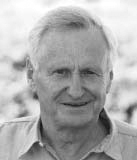 One of the more brutal and consequential adventure films in modern cinema, John Boorman’s masterful 1972 film Deliverance lay chillingly bare the often violent conflict between man and nature. Based on James Dickey’s bestselling novel, it followed four urbanized outdoorsmen from the city - played by Jon Voight, Burt Reynolds, Ronny Cox and Ned Beatty - as they sought to conquer an untrammeled river deep in the Georgia wilderness, only to find a series of threats to challenge their very idea of manhood.
One of the more brutal and consequential adventure films in modern cinema, John Boorman’s masterful 1972 film Deliverance lay chillingly bare the often violent conflict between man and nature. Based on James Dickey’s bestselling novel, it followed four urbanized outdoorsmen from the city - played by Jon Voight, Burt Reynolds, Ronny Cox and Ned Beatty - as they sought to conquer an untrammeled river deep in the Georgia wilderness, only to find a series of threats to challenge their very idea of manhood.
The scene Boorman describes here brings the foursome’s harrowing encounters with rape, killing, menace, and disappearance to a sad, thrilling, and cathartic conclusion as Voight and Beatty, with an injured Reynolds in tow and Cox missing, row through the last treacherous bit of rapids. Boorman and cinematographer Vilmos Zsigmond led a skeleton crew that only occasionally included a sound recordist, so dialogue was shot without a guide track. The director concentrated on visual clarity, aiming to match the shots he envisioned to the emotions of the moment, with no small amount of filmmaking hardship. For his efforts, Boorman received a DGA and two Academy Award nominations.
Revisiting this critical and commercial hit is more pleasurable for Boorman now than it was in the wake of its release. “For two or three years after I made it,” he says, “I couldn’t watch it without feeling all the bruises I got during the course of shooting it. Now I’m quite pleased that it has this physical, rhythmic dynamic to it.”
We looked at a couple of rivers, and we asked people, and one or two rivers were recommended. But most of the rivers I looked at, the banks were trodden down by fishermen. They looked used. I wanted something primal, and eventually someone said, ‘You should look at the Chattooga, but it’s impossible to film on because you can’t get in.’ Well that piqued my interest. This stretch of the river had these wicked, jagged rocks. It looked extremely malevolent, and it had a threatening air to it, and that’s where they find Drew’s body pressed up against a rock.
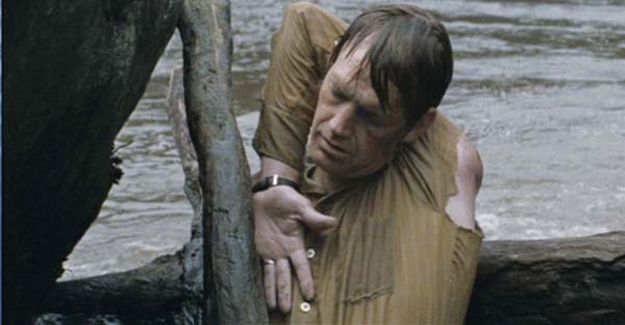
This scene had so much going for it: the roaring river, the exhaustion from all the hazards they’ve been through - both physical and psychological - and then Drew’s disappearance and finding him in this situation. Well, one day Ronny Cox was fooling around with my kids, and he revealed he was double-jointed. He could take his arm and put it around his back, over his shoulder. As soon as I saw that, I thought, ‘Oh, that’s the answer.’ We just smeared a little paint on his arm to make it look bruised, and stuck him against a rock.
At that time, Jon was a very intense actor. His initial response to a scene was always brilliant, but he felt it was too easy. He had a tendency to intellectualize. But here, Jon makes this little speech, a prayer, like a burial moment. It wasn’t scripted. We made it up right at that moment. Jon says something like, ‘I’ll do whatever I can for your two sons,’ and just made up the names. He did it beautifully, just the right degree of dignity and sorrow.
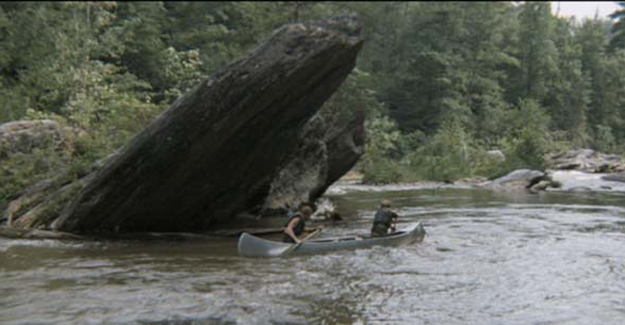
When I was scouting and taking pictures, the river looked so pretty and benign. So I decided to desaturate the scenes on the river, so it’d look more ominous. At that time, I’d make a black-and-white negative, print it, then print the color negative with the black-and-white one to a certain degree. So you add in black and white, or conversely take out some color. It took me six months in the lab afterward. Vilmos by that time had gone on to another picture, so I was stuck in the lab. It was a monstrous effort. I couldn’t do it by sequence, either; I had to do each shot differently.
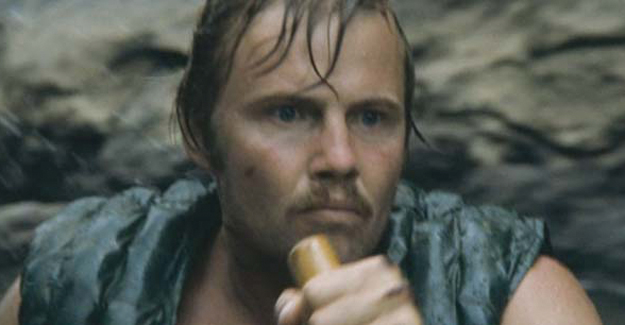
This shot was done with the camera in the canoe. We took Ned Beatty out and put Vilmos in, with the camera propped up on his legs. A shot like this, you need the action of the faces, the emotion on them, interspersed with the wide shots, to give it context. Vilmos was a terrific cameraman, very good at improvising situations. The canoes were long enough, too, so that I was able to get the camera far enough away from the actor so we could use a decent lens and not a wide-angle lens.
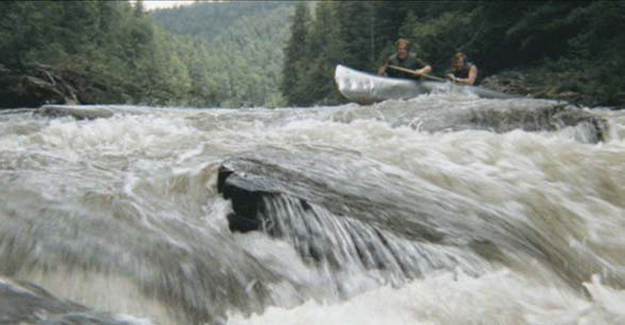
Of course, the lower you get the camera to the water, the more dramatic it all looks. A lot of the time we were on a tripod with the legs on the bottom of the river. All these shots are rehearsed and I had a couple of divers who acted as stand-ins, and I’d say, ‘Look, we’re going to bring the canoe from that point to that point,’ and then we’d rehearse the focal points of the shots. We’d do that a few times, then put the actors in. Burt was the complete opposite actor from Jon. Burt’s approach to a scene was, “I know how to get through this,” whereas Jon’s was to dig out every morsel, to intellectualize it.
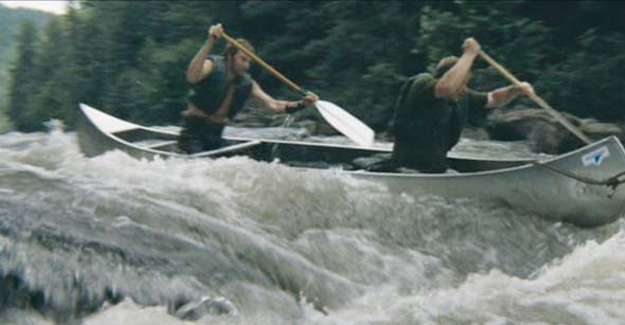
We trained the actors for a long time, and they were pretty expert at canoeing by the time we started shooting. The one in back controls the canoe. He’s the senior member, as it were. It was a very difficult section to shoot, because it was hard to go back and do a shot again. If you’d gone down a set of rapids, you’d have to then get on to the bank, carry the canoes back up to a higher point, and do it again. And the banks of the river were often very tangled and dense. So we’d try to get it in one shot if we could. But often it needed more than one take.
Because I was going to desaturate the river scenes, I did some tests, and I found that if you’re going to desaturate from Kodak film, you have to avoid primary colors. What happens is you find that midtones desaturate, and primary colors don’t. So in terms of the clothes and anything connected with the canoes, I had to avoid primary colors. Consequently, when we desaturated, everything came down at an even rate.
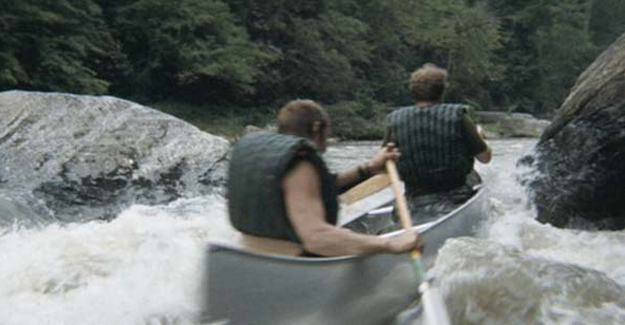
This is really Jon and Ned maneuvering between those rocks. We didn’t use doubles at all. In the whole picture, there’s only one shot where we used a double and that was an earlier scene. I never like using stuntmen because I feel if you’re using a stuntman you’re admitting that it’s dangerous. It’s so much better if you can use the actor. These guys were pretty courageous. That said, when I persuaded Jon to do this movie, he was in a bad way emotionally, ready to give up making films altogether. I dissuaded him from that, and he always said to people, ‘John saved my life, then spent the next eight weeks trying to kill me.’

We didn’t have an underwater camera. We used an Arriflex, and for shots like these when we were in the water, we made a water box with a glass window. It was waterproof and you could just lower the camera into it and then guide it. We used it quite a lot, because that would give you the effect of the camera being slightly underwater. It had handles on it, too, and we all wore wetsuits, so the cameraman could just hold the handles, guide the box, and get these shots.
We always had a small crew. Each day we were on the river, we’d set out, the actors would have a plastic bag with their lunch in it, and they’d take any bits of makeup stuff they might want, like a comb, basic stuff. We’d set off, and I’d just have the grip, cameraman, myself, and a recording man when we could. Then one or two divers, who we used as stand-ins. We never had two cameras. It was too difficult to get it into position. Extra people were just more trouble than it was worth.
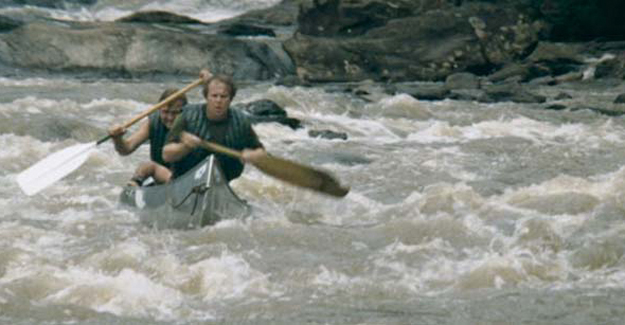
Here the camera was in the shallow part of the water, so as they came down, we were kind of zooming back, and panning with the canoe to reveal the cars on the bank. By this time, the actors were skillful at making the canoe hit its marks. I don’t shoot much film. I said at the start of the picture to the actors and crew, ‘I don’t shoot a scene from all angles, with closeups and mid-shots. Every shot I shoot is going to be in the picture.’ Because very often when you’re shooting coverage, the actor thinks, ‘Well, this probably won’t be in the picture.’ I said, ‘When my camera is rolling, every shot is going to be in the movie, so you’d better be ready.’
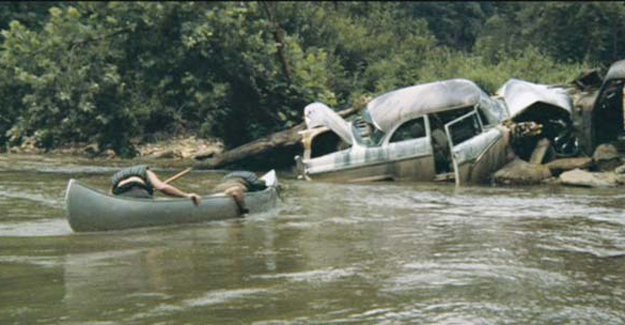
The irony here is that they’re so delighted to see these dumped, old cars, these wrecks, which represent civilization to them, you know? They’ve come out of the rapids, and down into calm water, and the camera moves to include these cars. I had canoed the river several times on my own, taking pictures, and this was one of the places I had found. The cars were brought in, and there was no problem finding dumps full of old cars in Georgia.
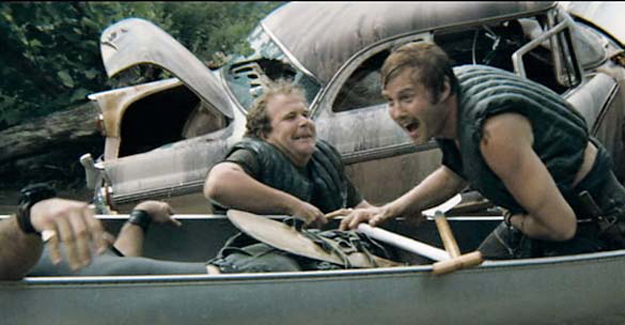
Ned wants to rush up to the bank, and this is when you see Jon’s character becoming harsher and more authoritative, while Ned’s character is becoming more infantile and lost. So a composition like this is very important. I always line up a shot using a viewfinder, an old Mitchell side finder. And on this particular film, the compositions all have to do with the dynamic of river, rock and man, and to give strength or weakness or whatever is the emotional requirement of the scene. And this sequence is the great transition Jon’s character goes through, where this comfortable, easygoing guy discovers these powerful emotions inside himself.